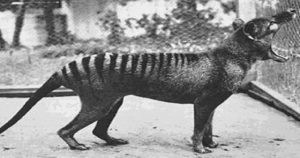
Climate Change Is The Reason Behind Extinction Of Tasmanian Tigers, Says Study
Tasmanian Tigers, an epitome of fury and aggressiveness, once an esteemed specimen, now an extinct one. Unlike conventional cats, this is a standout for its appearance and strength. Now, that after a long time, it is believed that there are no more Tasmanian tigers on earth. Coming to the factors that led to its extinction, it is assumed that climate change from the past 3,000 years ago in Australia might be the reason behind this.

According to the study by the University of Adelaide’s Centre for Ancient DNA, published in the Journal of Biogeography, the actual phenomenal changes started occurring from 4,000 years which was particularly driven by a greater tendency for more drought-prone seasons due to the “El Nino-Southern Oscillation” phenomenon, linked to changes in ocean and atmospheric heat.
Generally, known as a tiger-like species (though in no way related to tigers) because of its striped lower back, the Tasmanian tiger or thylacine used to inhabit areas of continental Australia and the island of New Guinea. However, when Europeans arrived in Australia in the 18th century, the population of this animal was concentrated on the island of Tasmania, southern Australia.

Meanwhile, history says that thylacines attacked their livestock, an intense hunting campaign was launched between 1830 and 1909 and encouraged by rewards, which subsequently contributed to the extinction of what is considered to be the largest terrestrial predator on the Australian continent.
Size and features of this animal are way too typical, they are of the size of a large dog, became extinct 81 years ago when the last one died in captivity in the Hobart Zoo on September 7, 1936. The animal, called Benjamin, was by mistake locked out of its sheltered sleeping area and died from the cold. There are people who claim to have seen Tasmanian tigers in the wild in recent years, but no scientific proof of any remaining animals have been provided.
Jeremy Austin, a research coordinator and deputy director of the Centre for Ancient DNA has said, “But the reasons for its disappearance in mainland Australia and its continued survival in Tasmania remain a mystery.”
On the whole, the reasons for the extinction have been attributed to climate change, an increase in human activity or the presence of dingoes, the Australian wild dogs, Austin added.